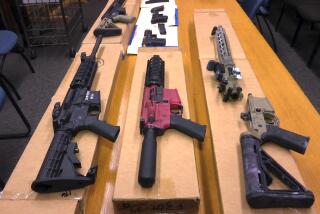Sale of A-Bomb Devices Is OKd
- Share via
SAN FRANCISCO — A federal judge Friday morning brushed aside the government’s attempt to invalidate the auction of two devices that helped detonate the first atomic bomb, saying the military had not proved that the artifacts are classified material.
Government attorneys had initially sought a restraining order to block last Tuesday’s auction, then seemed to hedge their bets by asking for more time Friday.
At a brief court hearing, U.S. District Judge Susan Illston denied the government’s case on both counts--declining to give the military time to investigate the plugs by taking them apart and ordering that the sale, which had been on hold, be completed immediately.
The judge said the dispute over the thumb-sized artifacts--two of the last remnants of an event that hastened the end of World War II and ushered in the Nuclear Age--was “not a national security issue.”
The San Diego-area retiree who bought the devices was ebullient as he walked from the federal courthouse to the offices of Butterfields Auctioneers to pick up his purchases.
Clay Perkins, a Rancho Santa Fe resident and former General Dynamics rocket scientist, said he was inspired to become a physicist in part because of the atomic bombs.
Perkins and the auction house had argued that the devices were personal keepsakes, not government property--and, more important, that their technology is little more sophisticated than that of many household appliances. Similar devices have even been on display at museums.
“One always believes a judge is wise if she agrees with you. And, of course, that’s what happened,” Perkins said. “But we thought it was clear. It was absolutely the right decision.”
The government could press its case, because Friday’s ruling was technically only on the request for a restraining order, not on the broader debate over the propriety of selling the devices.
But government attorneys declined to say whether they would take additional steps to try to gain control of the plugs.
Meanwhile, the plugs were on a plane with their new owner, headed home. They will be displayed, Perkins said, alongside a collection of military memorabilia, including a 16th century cannon lifted from a Spanish ship.
Butterfields spokeswoman Monique Crine said only that “we’re pleased with the results.”
The devices were part of “Little Boy,” the bomb the United States dropped Aug. 6, 1945, on Hiroshima, killing an estimated 80,000 people instantly and leaving a radiation cloud that eventually killed tens of thousands more.
Along with a second bomb, dropped later on Nagasaki, the attacks forced Japan to surrender and effectively ended World War II.
Morris Jeppson, a weapons tester and a member of the Enola Gay crew that dropped the bomb, grabbed the two devices at the end of the mission and took them home. One is a green switch that defused the bomb until it was ready to be dropped, and the second was a red switch that completed the bomb’s circuitry and allowed it to explode.
The devices were sold as part of a larger military memorabilia sale organized by Butterfields. Perkins bought the plugs for $167,500, most of which will go to Jeppson, now a Las Vegas retiree.
More to Read
Inside the business of entertainment
The Wide Shot brings you news, analysis and insights on everything from streaming wars to production — and what it all means for the future.
You may occasionally receive promotional content from the Los Angeles Times.











